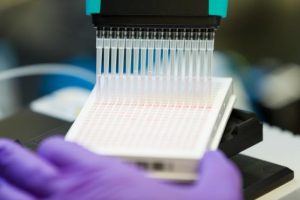Printable enzyme-stabilizing hydrogels for biosensing and drug discovery

Tech ID
17-072
Inventors
R. Mateen
M. Ali
T. Hoare
Patent Status
US and CA patent applications filed
Stage of Research
Proof of principle data is available
Publications
Contact
Carmen Carrasquilla
Business Development Manager
Abstract
Immobilization of biomolecules (i.e. proteins, enzymes) has significant implications in energy production, pharmaceutical synthesis, and drug screening. More recently, interfacial thin-film hydrogels enabling the stable encapsulation of enzymes have attracted interest in the biosensing field due to their potential to be incorporated into high throughput screening (HTS) screens in which high numbers of small volume samples can be tested. Traditional HTS methods present various challenges including false-positive hits and non-specific and/or promiscuous behaviour of compounds, typically due to aggregates that physically block (rather than biochemically bind to) an enzyme active site. As a result, time and money are lost chasing false lead compounds. To-date, there has been limited success in the discovery of methods to quickly identify these promiscuous compounds and aggregates.
To address this, McMaster researchers have developed a printable hydrogelbased drug-screening platform that can immobilize a bioactive biomolecule and control access to that biomolecule based on the hydrogel pore size. This approach is highly beneficial in drug discovery and early stage pharmaceutical testing and analysis because it provides the ability to discriminate between true enzyme inhibitors and promiscuous inhibitors for lead enzyme-targeting drugs while significantly reducing (by up to 95%) the amount of sample required for screening. This saves time and money when conducting HTS while resulting in significantly fewer false-positive hits. The hydrogel is also printable using an ink jet printer without requiring external activation.
Applications
- High-throughput Screening Applications
- Sensing and Analytical Applications:
- Paper-based Lateral Flow Sensor Fabrication
- Batch-based Sensing Technologies (i.e. DNA, cell binding proteins)
- Food Safety Monitoring
- Environmental monitoring (contamination of food supplies)
- Healthcare Diagnostics (metabolic or disease markers)
- Potential Genetic Screening Applications (with DNA encapsulated)
- Biomedical Applications
- Printable Gel Coatings for Implants that can deliver active protein-based therapeutics
- Tissue Engineering Scaffolds facilitating controlled release of growth factors at specific times
- Wound Healing Meshes deliver regenerating proteins promoting tissue regeneration instead of scarring
Advantages
- Does not require UV photopolymerization for crosslink formation
- Biomolecule is stably entrapped and not washed away when exposed to an aqueous environment
- Protection from enzyme degradation, chemical denaturation, denaturation via drying, and inhibition by other molecules that sterically block the active site of the biomolecule

